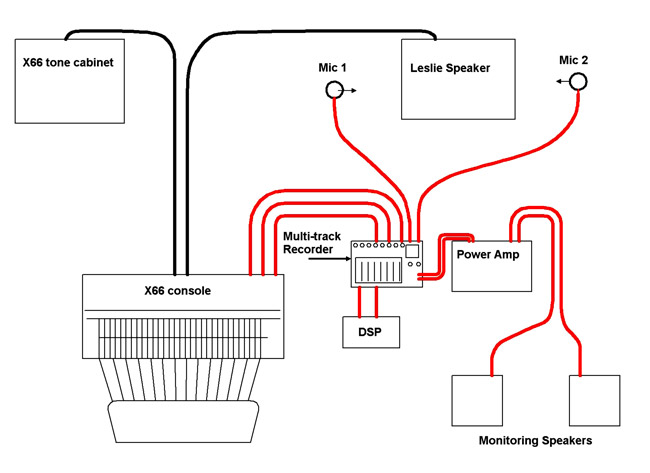RECORDING the Hammond Organ
North Suburban HAMMOND ORGAN Service

Figure 1. A setup which works very well for securing good results recording an X66 with Leslie speaker. The black cables are those which are part of the X66 installation. The red cables are those which are used for the recording setup. In this picture we also show the pair of studio monitor speakers, through which we listen to the output of the multi-track recorder while we do our mixdown adjustments. After the mixdown is complete, we will also listen to this mixdown through the studio monitors.The DSP attached to the multi-track recorder adds reverberation.
We’ll start this off by looking at a setup that will give you a very good-sounding recording from an X66 Hammond with an additional Leslie 122, such as we used for most of our concerts when we were operating a Hammond organ club and had monthly concerts. Here is a diagram of the recording setup.
At first look, it appears formidable indeed, but there really is not too much to it. In order to record this successfully, we are using 5 separate audio channels in a multi-track recorder. There are three essential audio channels that we want to take directly from the console preamp in the X66. These are the tibia A channel, the tibia B channel, and then (using Hammond’s terminology) the bright voice channel which gives us the tab voices, the percussions and the bass pedals. There is a fourth channel in the X66 console, the reverb channel, but we won’t bother with that one, because the X66 reverb is an original spring type unit [necktie box reverb] from the 1960s, and we can do much better with digital reverb which we’ll add in the multi-track recorder.
Inasmuch as we also have a Leslie speaker, we must use two additional channels because we can’t do justice to the Leslie sound by recording it in mono. Also, the Leslie effect is acoustical, added to the sound waves AFTER they leave the speakers. So in addition to the three direct channels coming out of the X66 console, we must add two additional microphone channels to get the Leslie speaker.
Although seemingly a lot of work, this will give us a final mixdown recording in standard two-channel stereo on a CD that will, as long as it is played back through a decent stereo, make it sound like you were sitting right there hearing it “live,” and that of course is the desired objective.
The term mixdown refers to the result of combining the many separate tracks of the multi-track recorder. Although the multi-track recorder records on a number of different tracks simultaneously, it is arranged to output a standard two-track stereo signal. What it does let us do, however, is to treat each individual mono track as a separate entity so that we can independently adjust the bass, midrange and treble of each track. Also, by means of a panning control, we may place each track either entirely on the left or entirely on the right channel of the final stereo mixdown, or we can split it up so that say 75% of a track could appear on the right channel of the mix and 25% on the left. In the recording trade this is referred to as either panning or placing a track in the stereo field. There are other things that we may do to each track in the multi-track recorder which we’ll touch upon later, along with taking a closer look at both multi-track recorders and mixers.
Back to intro. Go to Page 2. Page 1.